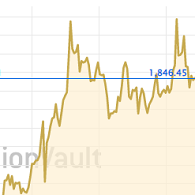Silver Overbought But Not Over
Lessons from silver investing history...
FOR DECADES I've gazed onto trading screens, watched tickers scroll, and
felt both the rush of a
moonshot and the sting of a sudden reversal, writes Kevin Bambrough in Addison Wiggin's Daily
Reckoning.
If you've been around long enough, you know the narrative well.
"Silver is
overbought," say the experts,
pointing to a stretched RSI or a yearly chart that looks more mountain than plateau. And, yes,
eventually, the crowd will be
right.
Tops do form. Corrections do come. But here's the part I learned staring
at those screens and studying
history's data sets on restless nights: overbought doesn't mean over, the correction might happen way
down the road, and even then, it
could just be a couple of percentage points.
Study the history of silver and
you'll see some of the greatest
percentage gains came after that big, scary "overbought" signal flashed red on the monthly
RSI.
We're
hardwired to seek safety. When a market looks stretched, every instinct says, "Not now, it's too late."
But silver teaches us a
different lesson, if we're paying attention.
I look at the RSI, the Relative
Strength Index, every month.
It's not just a measure of price, but momentum, emotion, irrationality. When it crosses 70 on the
monthly, commentators start to warn
of danger. "It's overbought."
Sometimes, truths hide in plain sight. Here's
what the data says about key
times when silver was "overbought" during in past bull markets:
Looking at the
charts, the so-called
"overbought" moments in silver, as defined by an RSI above 70, don't always signal the end of a rally.
Instead, they often mark the
beginning of sustained upward momentum.
Historically, these instances
frequently precede significant price
movements, where enthusiasm builds rather than diminishes.
This pattern
suggests that the emotion and
momentum captured by the RSI can sometimes indicate untapped potential rather than impending risk. It's
a reminder to approach these
signals with nuance, recognizing that a high RSI is not necessarily a stop sign − it might just be the
start of an extraordinary
run.
Let's take a look at the history of silver and when that RSI overbought
warning has flashed before in
past bull markets.
May 1967 to June 1968: Silver rose from $1.60 (RSI 91.91) to
$2.50 in 13 months (+56.25%),
with RSI easing to 77.17
Feb 1973 to Feb 1974: Silver climbed from $2.49 (RSI 75.56) to
$6.70 in just a year (+169.08%),
with RSI at 82.55
Jan 1979 to Jan 1980: Silver skyrocketed from $6.75 (RSI 73.31) to $48.00
in just a year (+611.11%),
with RSI reaching 80.56
Dec 2003 to Apr 2004: $5.93 (RSI 70.16) to $8.21 in 4 months
(+38.45%), with RSI jumping to
80.11
Jan 2006 to May 2006: $9.81 (RSI 73.58) to $14.75 in 4 months (+50.36%), with RSI
dropping to 64.66
Feb
2008 to Mar 2008: $19.80 (RSI 75.81) to $20.74 in 1 month (+4.75%), with RSI rising to 80.15
Oct 2010 to Apr 2011: $24.74
(RSI 73.84) to $48.45 in 6 months (+95.84%), with RSI reaching 82.17
Jul 2020 to Aug 2020:
$24.34 (RSI 70.21) to $28.91 in
1 month (+18.73%), with RSI at 71.01
Each cycle is a meditation on patience and
conviction. The gains after
"overbought" matter more than the warnings that preceded them.

Rewind
the tape to the 1960s and 70s.
Inflation, geopolitical risk, monetary uncertainty. Silver's RSI pierced 70 not just once, but several
times. Some of the greatest
rallies happened after those signals.
Jump to 2003 to 2011. The story rhymes.
Each RSI surge didn't cap the
move; it signaled lift-off. I remember those whispers in the chatrooms and the magazine covers warning
"too far, too fast". Yet those
who listened to fear missed the main act.
Fast forward to 2020. The same themes
emerged − monetary
uncertainty, inflation fears, and geopolitical tensions. Silver's RSI crossed into "overbought"
territory again, and instead of
signaling the end, it paved the way for another rally.
What about today? The
chart feels explosive. If
history is any guide, the "overbought" chorus could be the opening riff, not the encore. Glance at the
charts. Notice how major bull
markets have long periods of sustained high RSI well over 70. Conclusion, we are just getting
started.
Sometimes, the so-called "smart money" − the funds and traders who rotate out at early profits − misses
the paradigm shifts, the
herding, the mania that changes markets. For example if billions in India and China decided, even for a
moment, to buy one or two
silver coins each, supply fragility would surface.
We don't have enough silver.
Think about it:
Global population in China and India exceeds 2.7 billion. If even 5% wanted a single ounce,
the outflow from futures,
ETFs, and vaults would be historic.
The market is simply not prepared for a
surge in physical demand at
scale. No amount of leverage in paper contracts changes that underlying reality.
Industrial demand forms the
bedrock beneath price. Consider this:
- Silver is crucial for solar panels, electronics, medical devices, and advanced batteries.
- With global decarbonization and the rise of electric vehicles, demand isn't just robust; it's accelerating.
- Supply chains are tight. Mine production can't be ramped overnight. Above-ground stocks are lower than you'd think.
- Central banks, quietly stacking gold for decades, may soon turn to silver. Monetary history hints at these turning points. Historically, when official actors shift bias − even slightly − markets can move with stunning speed.
Have you wondered why central banks rarely talk about silver? Perhaps because its time is closer than
we realize.
Every overbought narrative comes down to caution. But caution, in the hands of the
insightful, becomes preparation − not
paralysis.
Here's what I've learned from both peaks and valleys:
- Don't tune out the noise. Listen deeply, but don't mistake consensus for truth.
- Study the numbers, but trust your preparation. Those who waited for confirmation or a "safe" re-entry in major silver bull runs often watched the ship sail.
- Use RSI as context, not command. When the monthly screams "overbought," see if it's actually the starting gate.
The silver price story is more than just dates and numbers; it's a meditation on human nature, crowd
psychology, and the eternal
search for value. I've watched friends cash out at the first sign of smoke, only to miss the fireworks
that followed. I've seen new
buyers hesitate, only to chase rallies after the steepest climbs.
What will
this era hold? Maybe central
banks will step in. Maybe hundreds of millions in the East will seek a piece of "hard" money. Maybe,
just maybe, the real move begins
after we hit "overbought".
There's a lesson in every rally, a parable for every
chart. Are you willing to see
overbought not as the end, but as a doorway?
If you seek answers in the crowd,
you'll finish with the crowd.
The greatest gains go to those who read beyond the warning signs and trust their conviction.
Overbought?
Sometimes, that's just where the story truly begins. If so, the pull backs will be short and shallow,
momentum will build and prices
explode higher. That's the pattern silver bugs all sense coming. Exciting times as high upside
volatility is a drug and just the
anticipation of it is intoxicating.













 Email
us
Email
us
